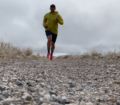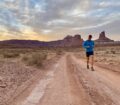Before running the GORE-TEX Transrockies 6-Day Race, most of my trail running experience had been with the ultra marathon crowd. Small handfuls of us would train for the same race, covering similar mileage and terrain, and bonding throughout the experience.
I knew a few people who would be at Transrockies, but it didn’t seem like a popular event among our regular ultra crowd. I wondered what the differences would be. What kind of people would we meet there? Trail runners? Ultra runners? Road runners?
Because we were sponsored this year, we didn’t pay the entry fee. Would we be surrounded by richer, snobbier people? Would we fit in with the group? The ultra runners we hang with are notorious for their carefree, grungy, and hippy-ish nature. They love single track, alcoholic beverages, facial hair, and questioning authority. Would this group be different?
We learned that Transrockies is like The Hilton of trail running. They really take good care of you . For the entire event, all you have to worry about is running, eating, and sleeping. Everything is done for you. The food is amazing, the amenities are great (as far as camping goes), and the staff and volunteers bend over backwards to make sure you have everything you need.
Here is how Transrockies compares to your typical trail ultra marathon:
1. More Course Markings
The markings at Transrockies were the best I’ve ever seen. There is pretty much no way to get lost if you are even remotely paying attention. We were thrilled with this, considering the markings at many ultras can be questionable. I’ve been lost more than once during an ultra, but never doubted the Transrockies course once the entire week.
Transrockies markings follow the path even when there are no other turns to be made. The turns themselves are marked obsessively, sometimes with real human beings telling you where to go. Very different than your typical ultra, where you sometimes have to make an educated guess.
2. More Competition
Transrockies had more of a competitive vibe than a trail ultra marathon. The competitiveness is closer to a marathon than an ultra. Finish times seem more important. People push themselves harder and try to finish strong, not just finish. At first, this thew me off a little, but I quickly learned to enjoy it. I started running better because of it, and we got stronger with each passing day, peaking our best performance on the longest running day.
3. More Roads
While most trail marathons avoid roads at all costs, this race is about 50 percent road. This makes it a great introduction to trail running for people who are more experienced on roads. If you’re a die-hard trail runner, it may be more road than what you’re used to. That said, the single track you do see is spectacular. And you will definitely get your fill of climbs and descents.
[Continued Below]
[tabs slidertype=”images” auto=”yes” autospeed=”4000″][imagetab width=”558″ height=”372″]http://trailandultrarunning.com/wp-content/uploads/2012/08/vanessa-rodriguez-gore-tex-trans-rockies-run-finisherjpg.jpg[/imagetab][imagetab width=”558″ height=”372″]http://trailandultrarunning.com/wp-content/uploads/2012/08/vanessa-rodriguez-gore-tex-trans-rockies-run-tracks.jpg[/imagetab][imagetab width=”558″ height=”372″]http://trailandultrarunning.com/wp-content/uploads/2012/08/vanessa-rodriguez-gore-tex-trans-rockies-run-trail.jpg[/imagetab][imagetab width=”558″ height=”372″]http://trailandultrarunning.com/wp-content/uploads/2012/08/vanessa-rodriguez-gore-tex-trans-rockies-run-group.jpg[/imagetab][/tabs]
4. More Road Runners
This is not an ultra running, or even a trail running crowd. There were some triathletes, a lot of road runners, and surprisingly–some people with very little racing or trail experience. Some had never completed a marathon. This made it amazing to watch people finish stages that they never thought they were capable of running. A lot of really determined people and very rewarding finishes.
At your typical ultra marathon, most people have roughly done the same amount of training–similar mileage, and similar trail terrain. A lot of them have even trained together. Here, there was a wide variety of athletic abilities and backgrounds. It was extremely diverse.
5. More Organized
Unlike an ultra, every detail is planned out. There is a reliable schedule you can refer to, and the night before each stage you can attend a meeting that reviews the course, describes the climbs, and talks about the aid stations. It is a lot more predictable than an ultra, and you know exactly what to expect.
6. More Accommodating
The general rule at any ultra is “no whining”. Here, whining and complaining are more likely to be met with a listening and accommodating ear. I had mixed feelings about this because although the special treatment was great, I wondered whether it attracted more “whiners”. Some people brought negative attitudes to the trails, and there seemed to be more egos than what is normally seen at an ultra.
7. More Freebies
You will never get more freebies or higher quality goodies at any race. We got shoes, blankets, jackets, energy bars, protein drinks, lip balm, and many other helpful items. On the way home, we had to check an extra bag on our flight to hold all the free stuff we got.
There were also daily draws for free gear. If you were a top finisher, you might also get electronics, hydration packs, clothing, or even camping gear. Prizes were also given to “Final Finishers” each day. Nobody walked away from this race empty-handed.
8. More Paparazzi
The race and video coverage at this race was mind-blowing. You will never see this extent of coverage at any ultra. At one point, we climbed to the top of a ridge to find that someone had lugged a 50-lb generator up there to take pictures and video of the runners. There were photographers everywhere. They knew how to pose you, sometimes telling you what to do as you ran by.
Several runners played to the cameras, which reminded us to smile and have fun throughout the race. The photos that came out of this race were extremely high quality and easily sharable. While we were racing, the photos were posted online so our friends could see what we were up to. We were filmed eating, sleeping, and running. You are treated like a celebrity.
9. More Networking
This race had a large number of higher rollers. A lot of journalists, editors, writers, and authors. For me, this made for more interesting conversations and some great networking opportunities. I collected a couple of business cards, but didn’t think to bring any for myself. If you’re representing a website or promoting a publication, I’d highly recommend running with business cards. You’ll meet some great people you’ll want to keep in touch with.
10. More Cutoff Flexibility
The cutoffs for this race are extremely generous. You have six hours to complete the first stage, and nine hours to complete all subsequent stages. You could walk the entire course and still finish. As long as you keep moving forward and manage to avoid serious injury or sickness, you can finish.
This takes a lot of pressure off the less experienced trail runners. While I sometimes have to plan for cutoffs during an ultra, I didn’t have to worry about them at all at Transrockies. If for any reason you can’t complete one stage, you are still allowed to continue running the next day. The staff and volunteers really want you to finish.
All in all, you get your money’s worth at Transrockies, and then some. For more rugged runners like us, it feels like a resort vacation. And running is much easier when you are this pampered.
Some stats from Transrockies:
300 tents are put up daily (it takes about two hours)
There are 50 volunteers and 50 staff
3000 gallons of water are used daily for the shower truck
50 20-lb bags of ice are used daily
The finish line catering uses:
1000 cups
100 watermelons
120 2L bottles of Coke, and 60 loaves of bread
One breakfast includes:
90 dozen eggs
40 lbs of bacon
25 gallons of regular coffee
1 1/2 cases of 36 lbs of oatmeal
One dinner incudes:
400 pieces of chicken
80 lbs of pulled pork
50 lbs of squash
20 lbs of red onions
60 lbs of peppers
5 cases of asparagus
Total mileage:
120 miles in 6 days





















Great review of a great race. We did it for the first time this year and really enjoyed ourselves.
[…] 10 Ways Transrockies Compares to a Trail Ultra Marathon […]